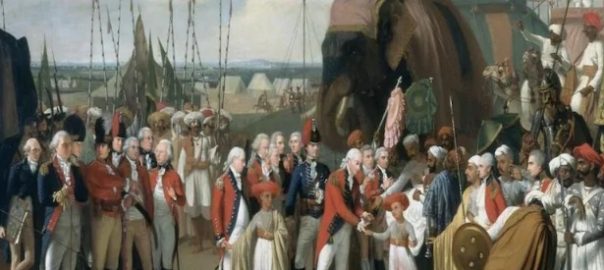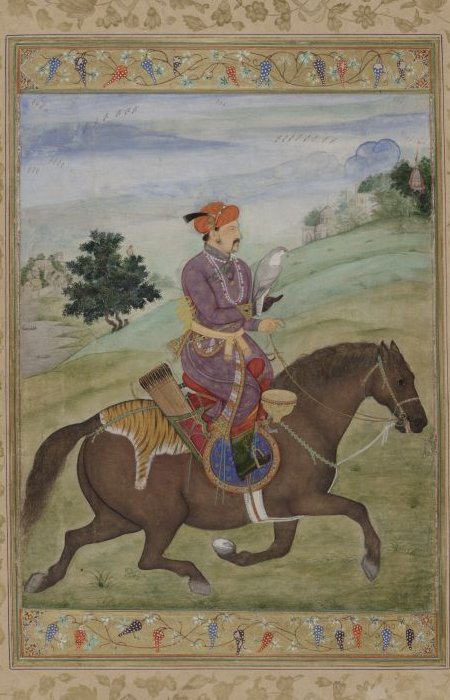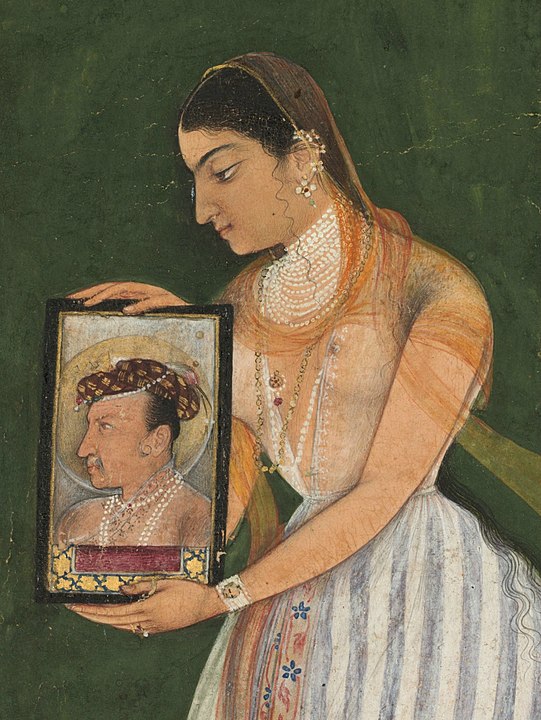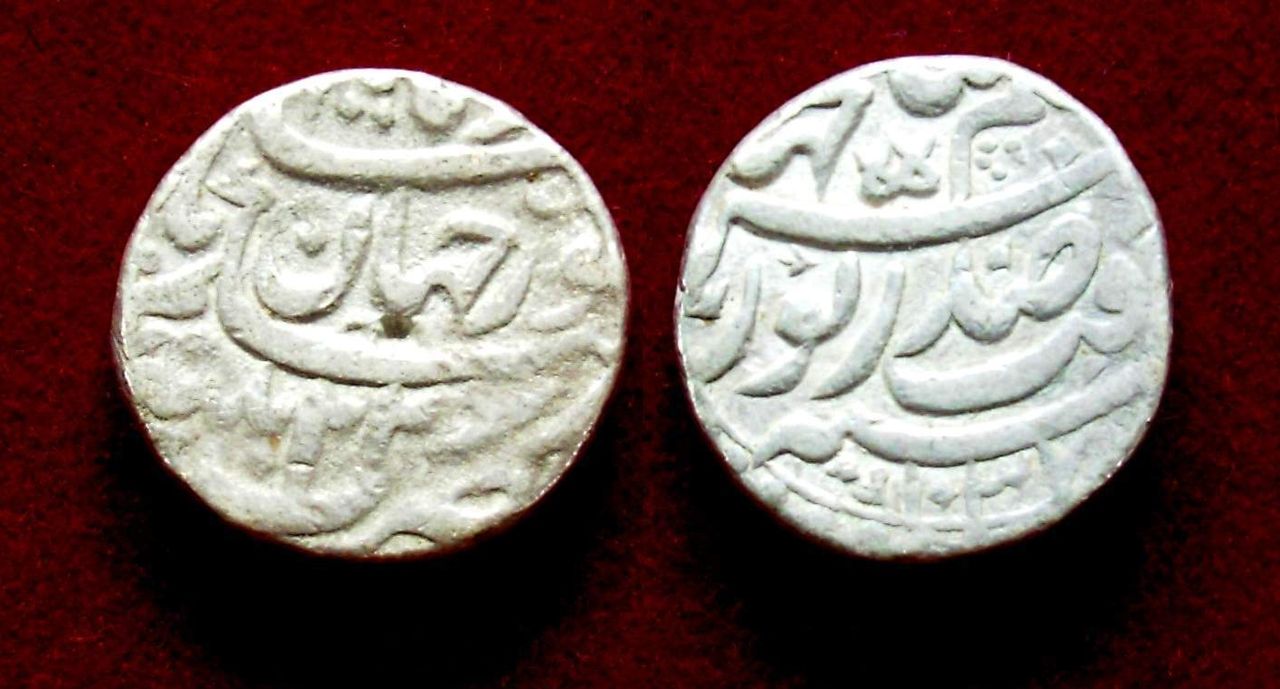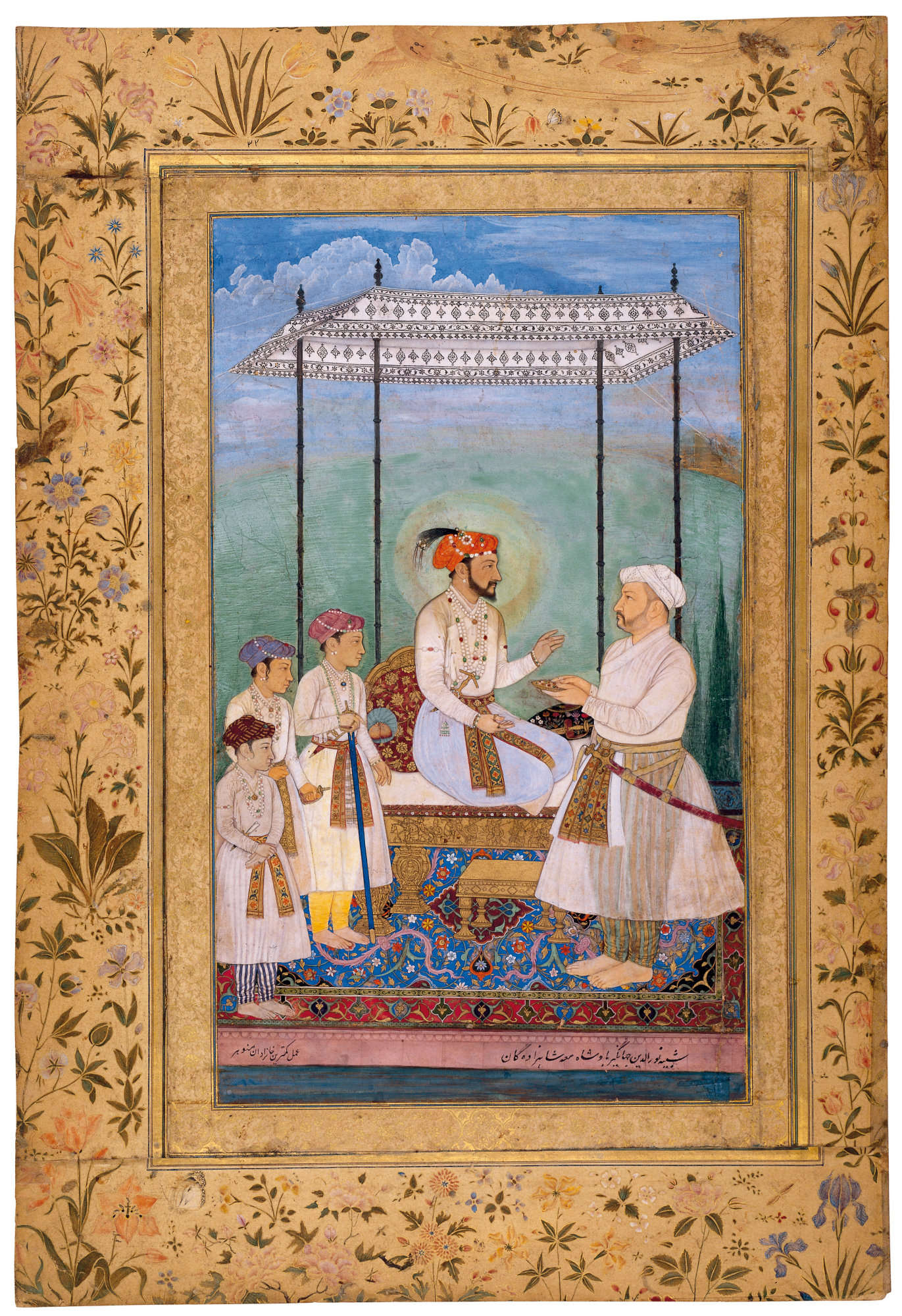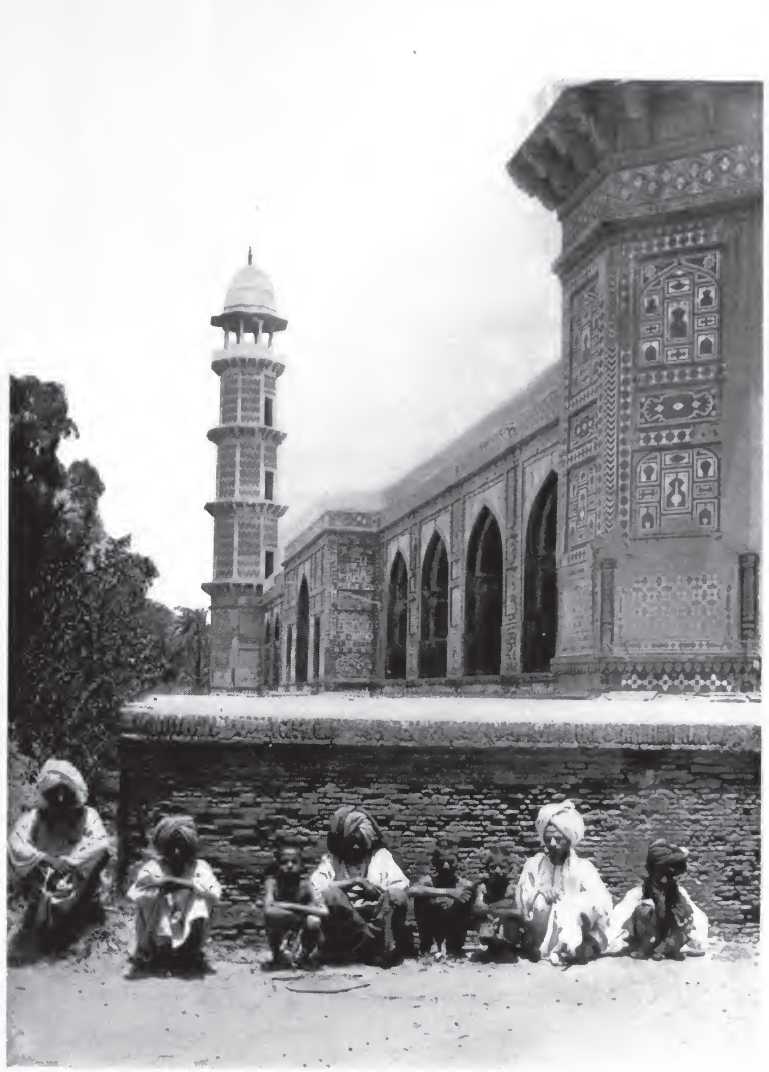In 1627 CE, the usual kinds of colonial practices continued, of course, to be pursued around the world by the raiding/trading empires of Portugal, Spain, England, and Netherlands; and in Europe, the Thirty Years War continued to roil Central Europe while Spain and Netherlands continued to pursue their Eighty Years War.
But today I’m going to focus on the death of the Mughal Emperor Jahangir who died “of a severe cold” in late October 1627, while journeying from Kashmir to Lahore. Here, I shall first quickly examine the reign of Emperor Jahangir, including the role of his favorite wife Nur Jahan and the immediate aftermath of his death, then I’ll look at the continuing inter-European struggles for influence especially at the Mughals’ main western port, Surat.
Part I: Jahangir, his spouse, and his ambitious children
Jahangir, born in 1569, was the oldest son of Emperor Akbar and had acceded to the throne in 1605. Akbar had done a lot to expand the empire from its heartland in today’s Afghanistan down into today’s India and with wide outlets onto the sea at both east and west. During Jahangir’s reign, he expanded it only a little. He also showed less interest in pursuing a kind of syncretic, pan-Indian (Muslim + Hindu) worldview than Akbar had, and had gotten into some bad fights especially with the Sikhs, whose Fifth Guru he had executed. He was widely considered to have a drinking problem and an addiction to opium.
In many ways, the woman who became the favorite of his 20 wives, Nur Jahan, seems much more interesting than him. Nur Jahan was the daughter of one of Emperor Akbar’s officials and had first been married to a fairly famous Mughal military leader who was killed under somewhat murky circumstances. She was thus a widow with a nine-year-old daughter when she married Jahangir in 1611. When Jahangir was debilitated or out-of-sorts, she often took over the reins of government; and the empire even minted silver rupee coins bearing her name.
English-WP tells us this:
Nur Jahan possessed great physical strength and courage. She often went on hunting tours with her husband, and was known for her marksmanship and boldness in hunting ferocious tigers. She is reported to have slain four tigers with six bullets during one hunt… Nur Jahan’s courage, bravery and administrative skills would prove invaluable during her regency as she defended the Empire’s borders in her husband’s absence and navigated family feuds, rebel uprisings, and a war of succession brought on by the failure of Jahangir to name an heir before he died on 28 October 1627.
Tensions between her and some of her step-children emerged soon after she married their dad. Of her step-children, she favored Shahryar (who became her son-in-law.) But his half-brother Khurram resented that. At one point (date unclear), the Safavid Persians were besieging Mughal-controlled Kandahar, at a time when Nur Jahan was running the empire.
Then this happened:
She ordered Prince Khurram to march for Kandahar, but he refused. As a result of Prince Khurram’s refusal to obey Nur Jahan’s orders, Kandahar was lost to the Persians after a forty-five-day siege.Prince Khurram feared that in his absence Nur Jahan would attempt to poison [his father’s mind] against him and convince Jahangir to name Shahryar the heir in his place. This fear brought Prince Khurram to rebel against his father rather than fight against the Persians. In 1622 Prince Khurram raised an army and marched against his father and Nur Jahan. The rebellion was quelled by Jahangir’s forces and the prince was forced to surrender unconditionally. Although he was forgiven for his errors in 1626, tensions between Nur Jahan and her stepson would continue to grow underneath the surface.
It gets better:
In 1626, the Emperor Jahangir was captured by rebels while on his way to Kashmir. The rebel leader Mahabat Khan had hoped to stage a coup against Jahangir. Riding into battle atop a war elephant, Nur Jahan intervened herself to get her husband released. She ordered the ministers to organize an attack on the enemy in order to rescue the Emperor; she herself would lead one of the units by administering commands from on top of a war elephant. During the battle Nur Jahan’s mount was hit and the soldiers of the imperial army fell at her feet. Realizing her plan had failed Nur Jahan surrendered to Mahabat Khan and was placed in captivity with her husband. Unfortunately for the rebels, Mahabat Khan failed to recognise the creativity and intellect of Nur Jahan as she soon was able to organize an escape and raise an army right under his very nose.
After Jahangir’s death, there was a fierce struggle for the succession, especially between Kurram– who immediately proclaimed himself “Shah Jahan”– and Shahryar. (Nur Jahan, unsurprisingly, favored Shahryar.)
WP tells us of Shahryar that, “Since he was in Lahore at the time, he immediately took over the imperial treasury and distributed over 70 lakh rupees [= 7 million rupees] among old and new noblemen to secure his throne.”
But meantime, Asaf Khan, the powerful father-in-law of Shah Jahan (= Khurram) raised an army to fight Shahryar and Shah Jahan’s side won the battle. Shahryar was arrested and blinded. WP tells us, “Like all Mughal princes, Shahryar also had training in poetry and, after he was blinded towards the end of his life, he wrote a poignant verse titled, Bi Gu Kur Shud didah-i-Aftab.”
In early 1628, the 36-year-old Shah Jahan became the new emperor, and named Asaf Khan as his Prime Minister.
Nur Jahan was given an annual pension of two lakh and spent the rest of her days, confined in her palace in Lahore, along with her daughter Mihr-un-nissa Begum, the widow of Shahryar. Nur Jahan died in 1645 at age 68.
Part 2: Jahangir steering among the Europeans
When Jahangir acceded to the throne in 1605, the Portuguese, with their whole “Indies” headquarters located at Goa, halfway down India’s west coast, already had a strong naval presence in all the linked bodies of water that lay between there and the Horn of Africa, with forts at Diu and Surat in northern India, and dotted along the southern coast of the Arabian Peninsula. And Jahangir’s powerful father had been intrigued by many aspects of the Portuguese presence. In 1580, he even invited some Portuguese-protected Jesuits to come to his capital at Fatehpur Sikri, in Agra, to come and hold discussions with him.
At sea, the Portuguese were in a good position to control sea traffic in and out of the Mughal empire’s main port at Surat, and all the convoys taking Muslim pilgrims from India along the Red Sea to make the hajj pilgrimage.
Then in 1612, as we saw earlier, a small English fleet was able to defeat a much larger Portuguese fleet– and this happened just off the sandbanks that guarded the entrance to Surat itself, in full view of the large crowds of Indians gathered on the shore to watch.
A year later, WP tells us here, this happened:
In 1613, the Portuguese seized the Mughal ship Rahimi, which had set out from Surat on its way with a large cargo of 100,000 rupees and Pilgrims, who were on their way to Mecca and Medina in order to attend the annual Hajj. The Rahimi was owned by Mariam-uz-Zamani, mother of Jahangir and Akbar’s Rajput wife. She was referred to as Queen mother of Hindustan during his reign. Rahimi was the largest Indian ship sailing in the Red Sea and was known to the Europeans as the “great pilgrimage ship”. When the Portuguese officially refused to return the ship and the passengers, the outcry at the Mughal court was unusually severe. The outrage was compounded by the fact that the owner and the patron of the ship was none other than the revered mother of the current emperor. Jahangir himself was outraged and ordered the seizure of the Portuguese town Daman. He ordered the apprehension of all Portuguese within the Mughal Empire; he further confiscated churches that belonged to the Jesuits.
Oops. Bad news for the Portuguese!
Then in 1615, an English fleet at Surat repeated the show-of-expertise against a Portuguese fleet that the Indians had witnessed three years earlier– and they also had a formal ambassador “from King James” negotiating a treaty in Agra with the Emperor, (or perhaps his wife?)
The banner image at the head of this dispatch is a 19th century painting of the ambassador, Thomas Roe, presenting his credentials.
The early 20th-century English historian William Wilson Hunter (hereafter WWH) tells us in Ch. 7 of his book The European Struggle for Indian Supremacy in the Seventeenth Century, pp.201-206, what happened from 1616 on:
[A] halcyon period opened to the English at Surat. The crop-fields of Gujarat, with their miracle of two harvests a year, seemed a paradise to the storm-tossed mariners, as they rowed up the smooth channels of the [River] Tapti…
According to letters from India to the Company in 1616 and 1617, the only drawbacks to the Company’s success at Surat were the “voluntaries,” or private traders from England, who began to creep in, and who, when their speculations failed, became a burden on the factory, or turned Mohammedans “to keep them from starving.”
More formidable rivals soon came upon the scene. In 1616 a Dutch ship under Van den Broeck appeared in the roadstead, but was not allowed to establish a factory. Next year two Dutch ships got wrecked off the coast, and ten of the survivors remained at Surat. In 1618 they received a license from the Moghul government, notwithstanding the efforts of Sir Thomas Roe to “turn them out,” and in 1620 Van den Broeck returned to Surat as director of Dutch trade. But the Dutch, accustomed to barbarian island chiefs, did not realize that they had come under an empire which insisted on good behaviour, and could crush the petty infidel settlements by a stroke of the pen. Even the English, backed by the imperial order for trade, had to rest satisfied with the protection assured to all residents within the Moghul Empire, and were not allowed to fortify their house at Surat. [!] The Dutch attacks on native vessels now involved us in the common disgrace of the European name, and while the Dutch were slaughtering us at Amboyna, in 1623, the English at Surat were held responsible by the Moghul governor for the piracy of their most bitter enemies. He seized upon our warehouses, threw our president and factors into irons, and let them hold their consultations “in prison” for seven months, amid the revilings of “whole rabbles of people.”
The Moghul government, however, soon learned to discriminate. It ceased, at any rate, to confound the peaceable English traders, who paid their customs punctually and abhorred images, with the Portuguese, who prostrated themselves like Hindus before a tinsel goddess, and plundered the True Believers on the holy voyage to Mecca. In 1622 our factory at Surat had organized the fleet which destroyed the Portuguese power in the Persian Gulf, and so outflanked the northern base of the Portuguese at Diu, which had controlled the entrance to the Gulf of Cambay. The English, having thus freed the approaches at Surat from the menace of the Portuguese, came to be regarded by the Moghul viceroy as a useful sea-police.
But the Portuguese, although beaten out of the Gulf of Cambay and the Persian Gulf, still harassed the route to the Red Sea. Surat was the main exit of the empire to Mecca, and the Moghul government hit upon the device of employing one nation of the infidels against another to keep open the pilgrim ocean highway…
The English at Surat thus early won for themselves a recognized position as trustworthy payers of revenue and as a maritime patrol for the Moghul Empire. On shore the empire was, within its limits, all powerful, but at sea it depended on mercenary fleets. As it held in check the pirate nests along the western shores of India by subsidizing the Abyssinian chiefs who had settled on that coast, so it looked to the English at Surat to keep open the ocean path of pilgrimages to the holy cities of the Red Sea. The Moghul supremacy was essentially of land origin. It had started from Central Asia, spread from the mountain passes across the Panjab, forced its way through the Aravalli deserts to Gujarat, and followed the courses of two mighty rivers, the Indus and the Ganges, to the opposite shores of India. From the vast hinterland of Hindustan the Moghul emperors were constrained to find an outlet to the ocean. But the great distance of their capitals in North-western India from the coast rendered it impossible, when they had found an outlet, to exercise an effective sea-control.
On the east, Portuguese buccaneers and Arakanese pirates swept the Bay of Bengal, and the Moghul viceroy had, by a special tax, to maintain an armed flotilla to keep open the mouths of the Ganges. On the west, the royal galleons and frigates of Portugal blocked the approaches to the Indus and the Gulf of Cambay. What the river fleet of the Bengal viceroy did for the Gangetic delta, the Indian emperors resolved that the English at Surat should do for the Arabian Ocean. Our squadrons formed, in fact, the naval complement to the land-conquest of Gujarat by the Moghul Empire. The anarchy which had ended just as we arrived gave place to a period of prosperity unexampled in the history of the province. Caravans came and went to all the inland capitals of India – Golkonda, Agra, Delhi, Lahore; the products of Asia, from the Straits of Malacca to the Persian Gulf, were piled up on the wharves of the Tapti. Merchants flocked in such numbers to Surat that during the busy winter months lodgings could scarcely be had…
The Company saw the position which its little band of servants had won on the Gulf of Cambay, and recognized the president at Surat as the chief of the English in India. After Amboyna the hopes of reviving the trade in the Spice Archipelago flickered out, and in 1630 even Bantam, its headquarters in Java, was declared subordinate to Surat.
